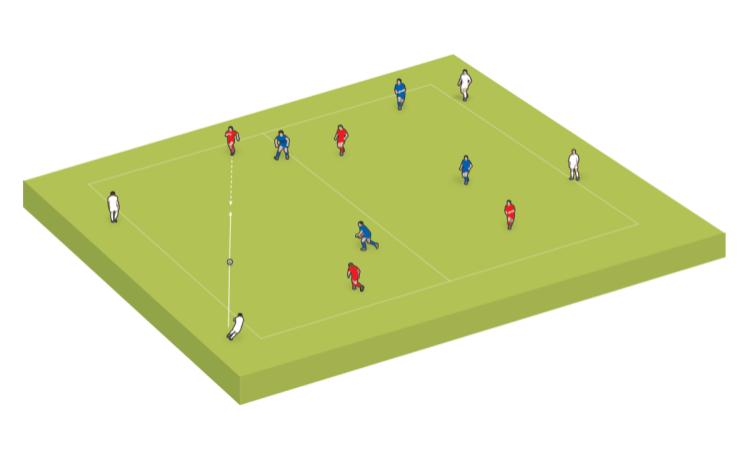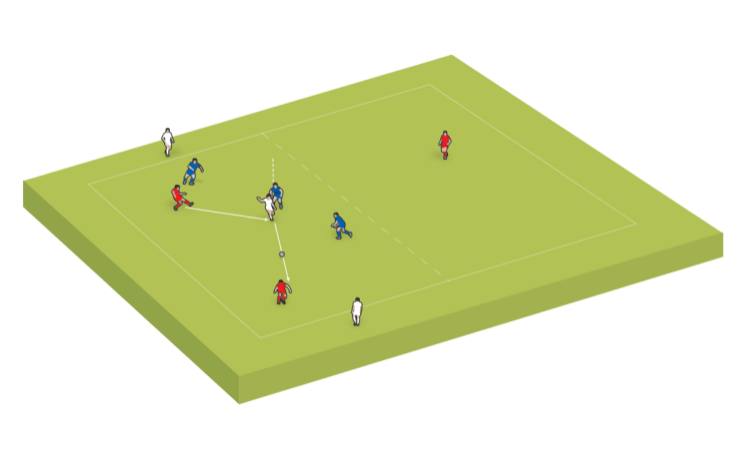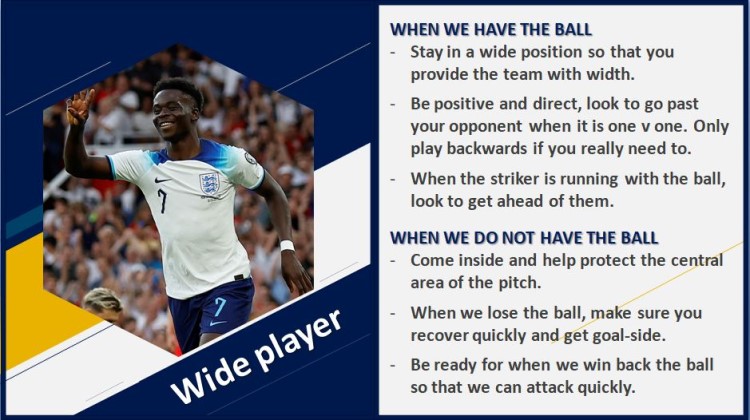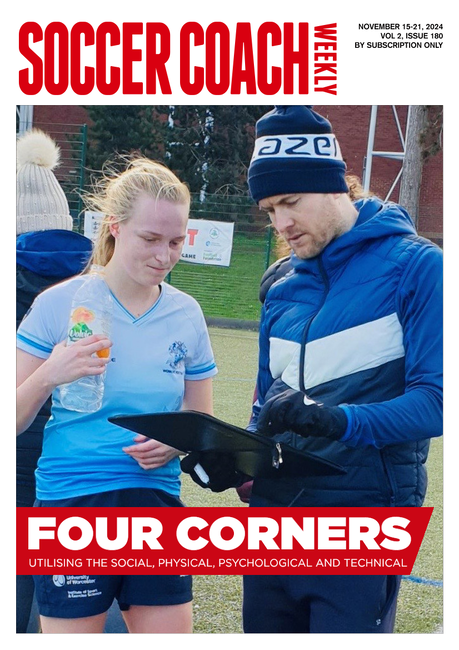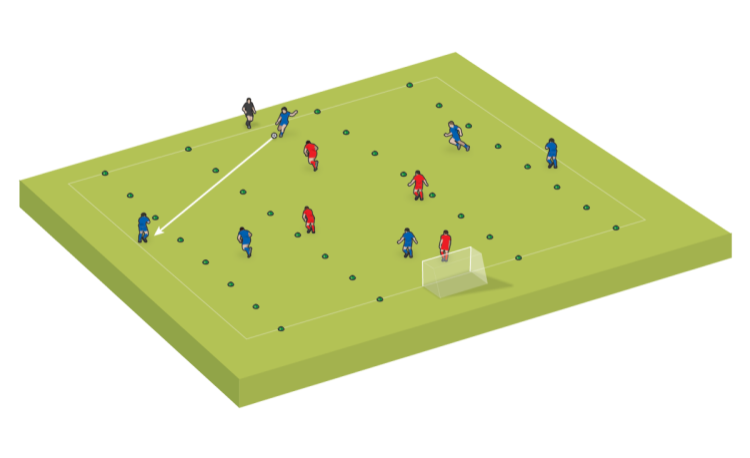Prepare players for the move to seven-a-side
Larger goals, more decision-making, positional principles to learn... Carl Wild provides a guide for coaches whose teams are taking the leap from five-a-side.
When players move from playing four- or five a-side to the seven a-side game, they will experience a number of differences – both the pitch and the goals will be larger, for example.
There are two particular challenges. The first is the increase in the number of players, meaning each will have to deal with a much higher level of decision-making.
The second is the fact that, although players will have had some notion of positions in the four- and five-a-side formats, seven-a-side is their first real introduction to game understanding of these positions.
In other words, there is a much greater emphasis on the players understanding the specifics of what they need to do in the position they are playing.
These two challenges also link into some of the main principles of the game, which become more relevant in the new format.
Out of possession, there is more emphasis on compactness, as well as cover and support. In-possession principles that come to the fore are space, movement and support.
To help players through this transition, we can provide them with support during both games and training. This should begin before the move to seven-a-side, and continue once they have fully completed the transition.
Support through training
Add options into practices: As there is more of an emphasis on decision-making at seven-a-side, we need to prepare the players by increasing the number of opportunities to make decisions during training.
One way to do this is by providing the players with options within the practice design. So, where we might have previously chosen a topic such as dribbling or passing, we can now combine these topics and have a focus on, for example, whether to ‘dribble or pass’.
When introducing this extra element of decision-making, the specific decisions to be made can be linked to the practice’s scoring system.
For instance, you might have designed a practice where, to win a point, a team has to get the ball into an end zone. To produce a greater emphasis on decision-making, we can allow the players to do this in more than one way – a player can dribble into the end zone or receive a pass inside it.
Or, if we continue with a narrow focus theme, we can provide a range of points that can be won.
In a finishing practice, for example, the teams might start with 10 points but, every time they pass the ball, they lose a point. So, if they manage to score but made six passes before doing so, they win four points.
Using this scoring system might encourage players to shoot as soon as possible. But they have a decision to make – if they pass it to a team-mate in a much better position, their team will get fewer points, but it is more likely they will score. Therefore, players need to make the right decision for the team.

Add areas into practices: Having areas within a practice can help players understand where they should be, aiding them with positioning.
The areas can be used in a number of ways:
- Locking players into them
- Having them as visual guides
- Linking them to rules such as: "there must be at least one player in this area when the team has the ball".
Marking out areas in practices provides the players with a clear picture of where they need to be positioned on the field in relation to their team-mates within different game situations.
By using areas, we can help players understand the correct distances and angles for when the team is in and out of possession.
Support through matches
Don’t move to seven-a-side too soon: Quite often, coaches are in a rush to help players prepare for the new format and simply throw them into playing games.
Though this might seem like a good way of helping the players, all we are doing is just getting them to play the format earlier with little support.
"By using areas, we can help players understand the correct distances and angles..."
Rather than placing them in this new environment prematurely, we can instead use a range of different support mechanisms to make it a smoother transition.
Give visual guidance on positioning: We may have positions and a specific formation within four- and five-a-side, but all players are usually involved all of the time. This is, of course, excellent for their development.
But, when players move to seven a-side, their contact with the ball begins to reduce. They must appreciate that, even though they are not in possession of the ball, or close to it, they can still impact what is happening in the game.
This is where positioning comes in. Players need to understand where they should be in different moments of the game, when their team is either in, or out of, possession.
As well as giving them verbal direction through a game, or showing them what to do beforehand and during breaks, we can give them visual guidance, by using markers to break the pitch into different sections. This can be done in non-competitive games, provided the opposition are happy.
Dividing the field into three vertical channels allows us to provide the players with some simple challenges, such as: "When we have the ball, can there be one player in each of the wide channels?".
If a team plays a 2-3-1 formation, the wide players will look to position themselves in the channels when the team has the ball.
The channels provide a visual trigger for the wide players and their movement will be a lot more natural.
Related Files
If we split the pitch into four equal quarters horizontally, the challenge, when the other team has the ball, will be for the players to be in only two adjoining quarters.
If we do this as the players transition to seven-a-side, and maintain it when they are playing it on a regular basis, the channels will be a familiar sight for the players and they will know what they need to do.
Use positional cards: These cards give players a basic outline of what they need to do in their position, the key points of the role and can be linked to professional players for inspiration (Arsenal and England’s Bukayo Saka is used in the example, above).
By sending out the cards in advance – the morning of the game, or the night before – players get a chance to prepare and remind themselves of what they need to do in the position they are playing.
The key reminders that are outlined on the cards can then be used throughout the game to help with the players’ development.
For example, a simple question of "Where should you be?" will encourage the player to reassess their position.
They will then recall the information on the card to help them come up with the answer.

Conclusion
When providing players with support as they move into seven-a-side, we need to identify the key aspects of the new format that are different to the four-and five-a-side formats they are used to.
Once we have done this, we must provide them with a range of environments that gives them an opportunity to practice these differences.
Most importantly, we need to be patient. Player development is a long-term process that cannot be rushed. We must accept that moving to a new format will take time and provide a lot of support along the way.
Newsletter Sign Up
Coaches Testimonials

Gerald Kearney, Downtown Las Vegas Soccer Club

Paul Butler, Florida, USA

Rick Shields, Springboro, USA

Tony Green, Pierrefonds Titans, Quebec, Canada
Subscribe Today
Discover the simple way to become a more effective, more successful soccer coach
In a recent survey 89% of subscribers said Soccer Coach Weekly makes them more confident, 91% said Soccer Coach Weekly makes them a more effective coach and 93% said Soccer Coach Weekly makes them more inspired.
*includes 3 coaching manuals
Get Weekly Inspiration
All the latest techniques and approaches
Soccer Coach Weekly offers proven and easy to use soccer drills, coaching sessions, practice plans, small-sided games, warm-ups, training tips and advice.
We've been at the cutting edge of soccer coaching since we launched in 2007, creating resources for the grassroots youth coach, following best practice from around the world and insights from the professional game.

